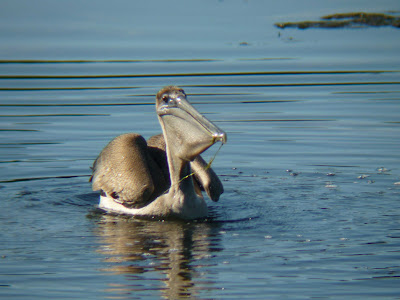
As liquid water as pretty much disappeared from Washtenaw county, except a little stretch of water at the beach of the arb, Diane offered me last Saturday the opportunity to go birding at Lake Erie Metropark, as she has another cat show at Allen Park. Saturday was a magnificent - and frigid - day, one of these days where Mr Winter shines, and when you don't regret at all the cloudy and rainy winters of the north of France. Oh boy, I love winter birding, for 3 reasons :
- First, you don't have to wake up at 5 in the morning and rush out to Starbucks (or, depending on the economic situation, Mc Donald's) and rush out to Crane Creek or Pointe Pelee to be there at dawn....So winter birding means waking up at 9 AM, drinking a warm coffee in the sofa and watching the Juncos and chikadees having breakfeast with the lone Pine Siskin that we have currently in our garden. Then, only after you have watched the news and drinked your second cup of coffee, you can fix some french toasts, and eat them while having your third cup of coffee, and start to think about how many layers you will wear today
- Second, for some strange reason , you have the whole park for yourself, most of the time. I mean, 1000 acres of marshland and lakes just for you and your binoculars. Which means you will never meet anybody who will tell you " what a shame you came so late, this morning we had an Iceland gull on the beach". Of course, you will never meet anybody to brag out about the very nice bird you just saw, either
- Third, it is usually so cold that you never regret to have a bit more time to do more birding.
As I arrived, the Parc Ranger told me : " you should probably go on the south side, on the north side, there is only mute swans". There was, effectively, a few mute swans. hundreds or even thousands of them, mixed with Tundra and Trumpeter's. There were also thousands of Canevasbacks (6,000?), hundreds of common mergansers and redheads, as well as all the commoners of michigan. What a show!!!!!! On the raptor side, a Northern Harrier was spotted, and a dozen Bald Eagles (half of them being juvenile) were seen flying over the open water
 Lake Erie metropark Lakeshore
Lake Erie metropark Lakeshore Mute Swans and Tundra Swan, and Canvasback, digiscoped
Mute Swans and Tundra Swan, and Canvasback, digiscopedSeeking a respite from the cold wind, I later went birding in the woods, close from the Hawk watching site. Here a few song birds, such as Robins, a lone Brown Creeper, White Throated Sparrows. But the stars of the day were a large flock of Redpolls (my first this winter). Among them, I noticed a much paler bird, making me think about the You-know-who.....But this tiny fellow did not want to be taken in picture, probably thinking that he deserved better than a digibinned picture. His darker friends were more cooperative...
 American Robin, digibinned
American Robin, digibinned Common Redpoll, digibinned
Common Redpoll, digibinnedThe Complete List was :
Location: Lake Erie MetroparkObservation date: 1/24/09Notes: 10F, clear skyNumber of species: 27 Canada Goose 0Mute Swan 3000Tundra Swan 2000American Black Duck 12Mallard 24Canvasback 6000Redhead 200Ring-necked Duck 12Lesser Scaup 12Bufflehead 24Common Goldeneye 1Hooded Merganser 2Common Merganser 300Ruddy Duck 12Great Blue Heron 6Bald Eagle 12Northern Harrier 2American Coot 2000Ring-billed Gull 6Herring Gull 1Mourning Dove 12Downy Woodpecker 1American Crow 2Black-capped Chickadee 12Brown Creeper 1American Robin 12White-throated Sparrow 4Common Redpoll 30This report was generated automatically by eBird v2(http://ebird.org/)

 Who is doing this racket? I listen carefully. No call notes, but the characteristic noise of cones being open....
Who is doing this racket? I listen carefully. No call notes, but the characteristic noise of cones being open....


 Brown Pelican (Pelican Brun), digibinned
Brown Pelican (Pelican Brun), digibinned 



 White Ibis (Ibis Blanc), p&S camera
White Ibis (Ibis Blanc), p&S camera





 Magnificent
Magnificent 









